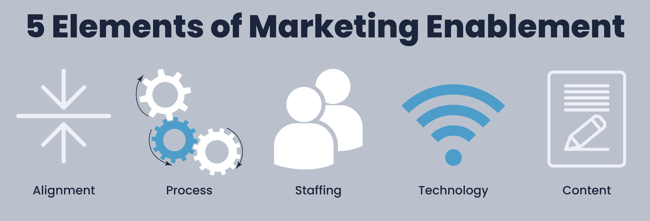Recently, at a cocktail party, I was asked the age-old question, “What do you do?” I replied that I was a Senior Marketing Consultant for an agency called 1 Bold Step that helps clients increase their sales and gain new customers by building a marketing machine for their business. I explained that most of my work lately has been focused on our client’s marketing operations and improving the business processes of the marketing department to be more efficient and impactful. They replied, “Oh, you do Marketing Enablement.”
Wait, what?!
Marketing Enablement
I’ve been in marketing a long time and while I’ve heard the term “Marketing Enablement,” I've always heard it in the context of the marketing technology that is used to enable the marketing department.
But as my friend at the party went on to explain, the concept of marketing enablement has been vaguely floating around for a long time, it just never really gained buzz-worthiness as sales enablement did.
So this morning I searched Google, but to my surprise, I only found two rather unsatisfying definitions.
“Marketing enablement is the process through which marketing-owned activities such as content creation, content storage, sales communication, and content analytics are made more efficient, improving overall Sales and Marketing alignment.” (Seismic April 27, 2018)
“Marketing enablement is a structured approach to boost productivity for teams of different departments. It involves ensuring marketing teams have sufficient technology to maximize the quality of their research, projects, and efficiency.” (Canto October 23, 2019)
The first two pages of Google search results didn’t return much in the way of authoritative content on marketing enablement.
I tried again – except this time I was more aggressive: “Define Marketing Enablement.” That led to another blog post by Seismic from this year. This one I liked.
“Marketing enablement is the process of making marketing teams more efficient by measuring the impact of the work they do. It encompasses the set of technology and practices that empower marketers to improve alignment with sellers. Through strategic insights, marketers can deliver content that resonates and orchestrates campaigns that drive buyers to act.” (Seismic March 23, 2021)
Not only is that a good definition of marketing enablement, but that's exactly what we do here at 1 Bold Step.
We’ve been using the term “enablement” since the inception of 1 Bold Step to explain one of the points in our three-pointed holistic approach to marketing operations. Our definition of enablement wasn’t called out specifically as “marketing enablement” but that’s what it means. Here it is.
“Put the right people (in-house or contracted) in the right roles doing the right things with the right systems to enable sales and generate revenue.” (1 Bold Step)
But good definitions will only take you so far. You may be wondering, what exactly is marketing enablement? I can tell you that you won’t find any good answers on Google. Since I now know that marketing enablement is what I’ve been doing for quite some time, let me break it down for you.

5 Elements of Marketing Enablement
1. Alignment (right things)
All marketing enablement starts with aligning the marketing department’s goals and KPIs with that of the overall organization. Marketing should be considered as a value-add and not overhead. If it is still being thought of as overhead, I guarantee it is not aligned with the goals of the company or being leveraged to help achieve those goals.
Once the marketing department has goals and KPIs a strategy and plan can be made to achieve those objectives.
2. Process (right roles)
Before you get the butts, you have to know the seats and knowing the seats means engineering good processes to get work done.
Every process needs a seat to own it. Processes are derived from the goals and KPIs. They are the work that must be done to make things happen. Through developing efficient processes, the marketing department becomes a lean machine helping to decrease costs and improve the return on marketing investment.
Once the marketing department has processes and roles defined it can look to fill those roles with the right people.
3. Staffing (right people)
This one is all about putting butts in seats.
Once you define the process and the roles, the next step is sourcing the right people for your team. That can mean hiring full-time employees or outsourcing. Here at 1 Bold Step, we provide Fractional Marketing Team services. That means we provide fractional full-time equivalents to fill roles for our clients because sometimes, the roles that get defined don’t need full-time people.
Our clients often need only a portion of a CMO, or 50% of a Director of Marketing, or 3 months of a HubSpot expert, or 20 hours a month of content writers and social media managers. We fill those roles for our clients so they don’t over hire and thus overspend.
In today’s dynamic business world, the right staffing solution is usually a mixture of in-house staff and outsource help.
4. Technology (right systems)
With the process and roles defined and staffed by the right people, it’s time to put the right technology in place.
This is no small task. There are literally thousands upon thousands of software providers in the market providing technology for marketing departments. Building a lean marketing stack takes an understanding of the processes that have been defined, and an awareness of what is available in the marketplace. More often than not, selecting technology requires the processes to be modified slightly based on the solutions selected.
At 1 Bold Step, we help our clients select the right tech to implement their marketing processes. We are a HubSpot Platinum partner, and find that platform does an excellent job of efficiently supporting the business processes of most marketing departments.
5. Content (enable sales and generate revenue)
With the right people, in the right seats, doing the right things, with the right technology… the only thing left to do is create excellent content that enables sales and generates revenue. That means inbound content like blog posts, sales enablement content, social media content, email marketing content, and traditional media content. Basically, it means turning on the “marketing machine” and putting those people, whether in-house or outsourced, to work driving “buyers to act.”
***
I’m going to use the term “Marketing Enablement” a lot more. Why should Sales Enablement get all the good press? Besides, it’s a great name for a good bit of what we do here at 1 Bold Step that has a substantial impact on our client’s businesses. We’ve been doing it ever since Jen and Adam started the company, we just didn’t know it had a name… until now.
I’ll be ready at the next cocktail party.
For more information about how we can implement marketing enablement within your business, click here. Otherwise, be sure to subscribe to our blog for more great content.



.png?width=700&name=content-3679757_640%20(1).png)

